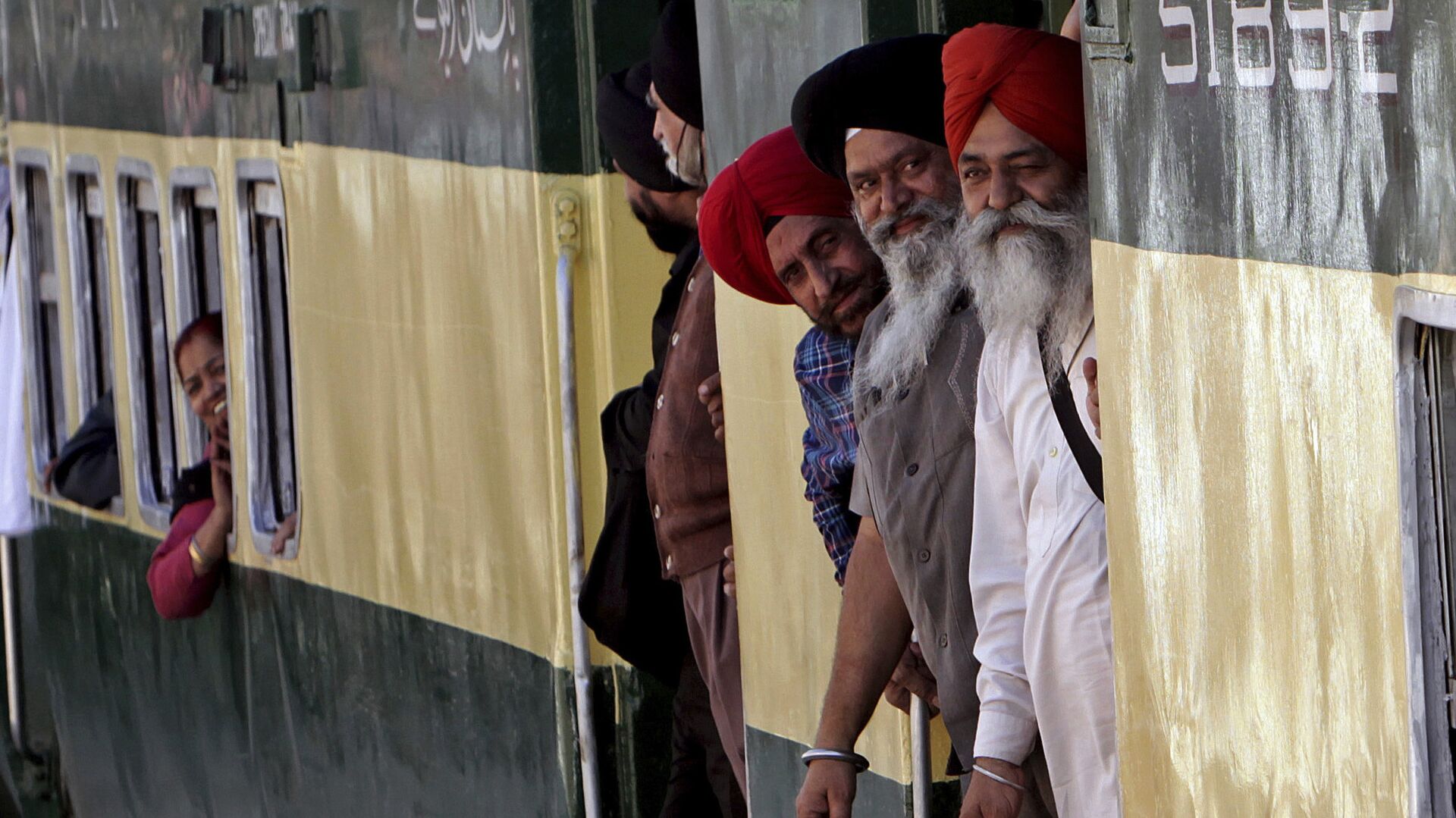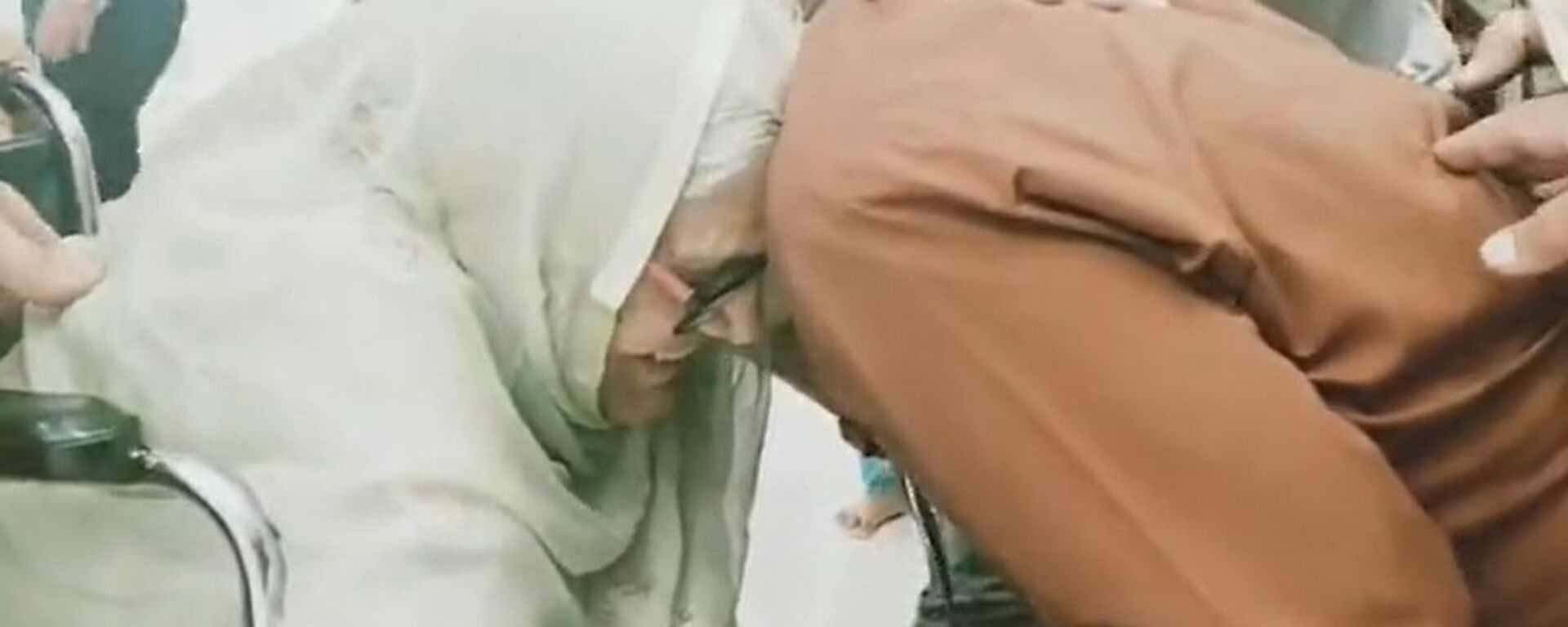https://sputniknews.in/20231030/what-drives-india-pakistan-to-forget-hostilities-for-pilgrim-visits-5141503.html
What Drives India, Pakistan to Forget Hostilities for Pilgrim Visits?
What Drives India, Pakistan to Forget Hostilities for Pilgrim Visits?
Sputnik India
Every year hundreds of Indians and Pakistanis get a chance to visit their neighboring country while visiting their revered religious places and old roots.
2023-10-30T21:18+0530
2023-10-30T21:18+0530
2023-10-30T21:18+0530
jawaharlal nehru
india
pakistan
new delhi
delhi
partition of india
political islam
political crisis
government of india
south asia
https://cdn1.img.sputniknews.in/img/07e7/04/0b/1502773_0:98:2121:1291_1920x0_80_0_0_dd833ecb433b051cf8c6b338735b0fd9.jpg
Away from the decades-long bitter memories of the 1947 Partition, many Indians and Pakistanis love visiting their neighbouring country, particularly to pay their obeisance at religious places. The latest is a group of 102 Pakistanis visiting India on Tuesday to be a part of the 720th annual Urs celebrations of Hazrat Nizamuddin Auliya. They will be starting their journey to India through the Wagah border. Sputnik India tries to explore what inspires the Indian and Pakistani authorities to continue this people-to-people contact, away from their routine bitterness of terror, infiltrations, or clashes.Ravinder Singh Robin, an Amritsar city-based journalist well-known on both sides of the India-Pakistan divide, shared that both the neighbouring countries currently do not have bilateral relations. He observes that India and Pakistan keep breaking and mending their relations like old brothers. But they share a few things that remain far away from the shadow of their diplomatic squabble. It may include border guard meetings over issues like infiltration, border maintenance, or border villagers' problems.Sometimes officials from either side exchange festive sweets on the border. Other times, they don't, the Sikh journalist and a regular visitor to border areas stated. Pilgrim Visas - Mandate None Can Put AsideBoth sides highlight that they allow each other's natives (pilgrims) across to the other side of the border. In reality, it's part of a pact between the then-Indian Prime Minister Jawaharlal Nehru and his Pakistani counterpart Liaquat Ali Khan. The pact mandates that both sides allow a certain number of visas, Robin shared with Sputnik. Although it's projected as a "goodwill gesture", the total visa count remains long overdue for a review in proportion to the population rise in India and Pakistan.Visa Issuance - Drop in OceanRobin opines that be it Indian or Pakistani, those finally getting a visa consider themselves lucky, as it's a tedious process, even the "Pilgrim Visa". "The reason being the number of visa seekers is literally 10-50 times higher than [those] who get it. So, it always feels [like] a drop in the ocean". Moment to Collect Unforgettable New Memories, Old Sorrows Every time, these pilgrims are found thanking the governments for letting them visit their desired holy places. But each time, the pilgrims leave while appealing to the governments to take a look at visa reforms (especially pilgrim visas), harsh restrictions, or easing requirements. Pilgrimage - Fostering Confidence, Promoting People-to-People TiesDr Priyanka Singh, associate fellow at the Manohar Parrikar Institute for Defence Studies and Analysis (MP-IDSA), opined that despite the overall frosty ties between India and Pakistan, the approval of visas for Pakistani pilgrims to attend the Nizamuddin Urs should not surprise anyone.India, as a secular plural society, does not inhibit the religious affairs of communities, including Muslims, who comprise the country's largest minority. Similarly, Sikh pilgrimages from India to sites in Pakistan have also continued irrespective of the dwindling interface between the two sides, the geopolitical expert remarked. The expert on Pakistani affairs believes that until political issues are resolved, it is best to continue to work together to harmonise communities in both countries. "Facilitation of pilgrimage across the borders is one such effective tool to foster confidence and promote people-to-people ties".
https://sputniknews.in/20230523/siblings-reunite-at-kartarpur-corridor-after-indian-partition-divided-them-75-years-ago-2113386.html
india
pakistan
new delhi
delhi
south asia
Sputnik India
feedback.hindi@sputniknews.com
+74956456601
MIA „Rossiya Segodnya“
2023
Sandeep Datta
https://cdn1.img.sputniknews.in/img/07e7/04/07/1468069_0:258:1800:2058_100x100_80_0_0_3909870b82375b0693e9fd27915facc3.jpg
Sandeep Datta
https://cdn1.img.sputniknews.in/img/07e7/04/07/1468069_0:258:1800:2058_100x100_80_0_0_3909870b82375b0693e9fd27915facc3.jpg
News
en_IN
Sputnik India
feedback.hindi@sputniknews.com
+74956456601
MIA „Rossiya Segodnya“
Sputnik India
feedback.hindi@sputniknews.com
+74956456601
MIA „Rossiya Segodnya“
Sandeep Datta
https://cdn1.img.sputniknews.in/img/07e7/04/07/1468069_0:258:1800:2058_100x100_80_0_0_3909870b82375b0693e9fd27915facc3.jpg
why india and pakistan allow visas to pilgrims, how pilgrims get visas in india, how anyone can get visa in pakistan, who is coming to india from pakistan, when pakistan pilgrims are coming to india, why pakistanis are coming to india, why india allows pakistanis to come to india, how can people visit pakistan, what is significance of pilgrim visa, how many places indians visit in pakistan, what happened in the indian partition, history of partition of indiaindian partition, indian partition act 1947, indian partition movies, partition horrors remembrance day, partition horrors remembrance day slogan, report on partition horrors remembrance day, who was responsible for the partition of india, how many hindu killed in 1947 partition, what were the consequences of the partition of india in 1947, why did partition of india happen, communal riots during partition of india, unheard tales of partition survivors, what happened during partition, stories of partition survivors, bagri hindu community, southern sindh province of pakistan, panic, dacoits, protection to the hindu community members, kashmore and ghotki riverine areas of pakistan, threatened to attack hindu places of worship and community members, retaliation to pakistani national seema haider, sachin meena, online gaming platform pubg, custody, violating immigration laws, human rights commission of pakistan (hrcp), deteriorating law and order situation, without a valid visa,
why india and pakistan allow visas to pilgrims, how pilgrims get visas in india, how anyone can get visa in pakistan, who is coming to india from pakistan, when pakistan pilgrims are coming to india, why pakistanis are coming to india, why india allows pakistanis to come to india, how can people visit pakistan, what is significance of pilgrim visa, how many places indians visit in pakistan, what happened in the indian partition, history of partition of indiaindian partition, indian partition act 1947, indian partition movies, partition horrors remembrance day, partition horrors remembrance day slogan, report on partition horrors remembrance day, who was responsible for the partition of india, how many hindu killed in 1947 partition, what were the consequences of the partition of india in 1947, why did partition of india happen, communal riots during partition of india, unheard tales of partition survivors, what happened during partition, stories of partition survivors, bagri hindu community, southern sindh province of pakistan, panic, dacoits, protection to the hindu community members, kashmore and ghotki riverine areas of pakistan, threatened to attack hindu places of worship and community members, retaliation to pakistani national seema haider, sachin meena, online gaming platform pubg, custody, violating immigration laws, human rights commission of pakistan (hrcp), deteriorating law and order situation, without a valid visa,
What Drives India, Pakistan to Forget Hostilities for Pilgrim Visits?
Every year, hundreds of Indians and Pakistanis get a chance to travel to their neighbouring country while visiting their revered religious places and ancient roots.
Away from the decades-long bitter
memories of the 1947 Partition, many Indians and Pakistanis love visiting their neighbouring country, particularly to pay their obeisance at religious places.
The latest is a group of 102 Pakistanis visiting India on Tuesday to be a part of the 720th annual Urs celebrations of Hazrat Nizamuddin Auliya. They will be starting their journey to India through the Wagah border.
Sputnik India tries to explore what inspires the Indian and Pakistani authorities to continue this people-to-people contact, away from their routine bitterness of terror, infiltrations, or clashes.
Ravinder Singh Robin, an Amritsar city-based journalist well-known on both sides of the India-Pakistan divide, shared that both the neighbouring countries currently do not
have bilateral relations.
He observes that India and Pakistan keep breaking and mending their relations like old brothers. But they share a few things that remain far away from the shadow of their diplomatic squabble. It may include border guard meetings over issues like infiltration, border maintenance, or border villagers' problems. Sometimes officials from either side exchange festive sweets on the border. Other times, they don't, the Sikh journalist and a regular visitor to border areas stated.
Pilgrim Visas - Mandate None Can Put Aside
Both sides highlight that they allow each other's natives (pilgrims) across to the other side of the border. In reality, it's part of a pact between the then-Indian Prime Minister Jawaharlal Nehru and his Pakistani counterpart Liaquat Ali Khan. The pact mandates that both sides allow a certain number of visas, Robin shared with Sputnik.
A fixed number of Indian Sikhs, Hindus, and Sindhis can visit five-six gurdwaras, the Katasraj Temple, or Shadani Darbar. Likewise, India allows Pakistani Muslims, Sindhis, and Sikhs access to some religious places.
Although it's projected as a "goodwill gesture", the total visa count remains long overdue for a review in proportion to the population rise in India and Pakistan.
Visa Issuance - Drop in Ocean
Robin opines that be it Indian or Pakistani, those finally getting a visa consider themselves lucky, as it's a tedious process, even the "Pilgrim Visa". "The reason being the number of visa seekers is literally 10-50 times higher than [those] who get it. So, it always feels [like] a drop in the ocean".
"Whenever India and Pakistan are on good terms, they regard each other as elder and younger brother. And then they can go on setting aside any official limit of visas", he remarked.
Moment to Collect Unforgettable New Memories, Old Sorrows
Every time, these pilgrims are found thanking the governments for letting them visit their desired holy places. But each time, the pilgrims leave while appealing to the governments to take a look at visa reforms (especially pilgrim visas), harsh restrictions, or easing requirements.
Asked what commonality he had observed while coming across such people, Robin said: "Their heartfelt desire remains that the number of visa allocations be raised, and that both India and Pakistan end their prevailing bitterness to ensure an everlasting peace".
Pilgrimage - Fostering Confidence, Promoting People-to-People Ties
Dr Priyanka Singh, associate fellow at the Manohar Parrikar Institute for Defence Studies and Analysis (MP-IDSA), opined that despite the overall frosty ties between India and Pakistan, the approval of visas for Pakistani pilgrims to attend the Nizamuddin Urs should not surprise anyone.
India, as a secular plural society, does not inhibit the religious affairs of communities, including Muslims, who comprise the country's largest minority. Similarly, Sikh pilgrimages from India to sites in Pakistan have also continued irrespective of the dwindling interface between the two sides, the geopolitical expert remarked.
Regardless of the situation today, she opined, the fact remains that both countries were one unit until 1947, and as such have much in common- cultural linkages and ethnic antecedents. It is, therefore, useful to insulate cultural bonhomie from the recurring disquiet on the Line of Control (de facto India-Pakistan border).
The expert on Pakistani affairs believes that until political issues are resolved, it is best to continue to work
together to harmonise communities in both countries.
"Facilitation of pilgrimage across the borders is one such effective tool to foster confidence and promote people-to-people ties".


